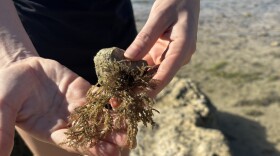We’re now in the middle of nesting season for Hawaiian sea turtles, which runs from April to September. After a historically busy season last year, conservation agencies are calling on the public to keep them safe.
The U.S. Fish and Wildlife Service, NOAA Fisheries and the state Department of Land and Natural Resources Division of Aquatic Resources are asking the public to keep their distance from nesting sea turtles.
Honu, or green sea turtles, honu‘ea, or hawksbill sea turtles, and olive ridley sea turtles are all endangered and nest on Hawaii beaches.
There are nearly 100 honu nests and an additional 44 honu‘ea nests across the state. Authorities have seen a rise in nests in the past few years, especially on O‘ahu.

Only a handful were documented in 2016, but 10 were found in 2019 and 58 in 2020. And 2021 is already on pace to surpass last year’s count.
Sheldon Plentovich, Pacific Island Coastal Program Coordinator for the U.S. Fish and Wildlife Service, told us about some theories for the increase.
“It's difficult to figure out why there was more nesting activity on O‘ahu in 2020 because there's a couple of confounding factors," Plentovich said. "One is that the beaches were mostly empty because of covid, so there might have been just fewer people disturbing nesting females."
"Another confounding factor is that in 2018, Hurricane Walaka destroyed East Island which is in the French Frigate Shoals and is the primary nesting island for green sea turtles in Hawaii," she said.
On O‘ahu, Hawaiian sea turtles are normally found on the North and East shores, but they can appear on any beach. You are most likely to see a nesting sea turtle at night, well above the high tide water line, and near the vegetation line.

“If you do see them, the most important thing is to keep nesting sea turtles in the dark. That means don't use your phone screen, don't use flash photography, don't use the white flashlight," Plentovish said. "All of those things disorient nesting turtle and hatchlings which we'll start seeing about 50 days from now.”
Disorienting bright white lights can also come from trail lights, floodlights on homes and street lights. Plentovich says they try to shield nests from light when they are identified.
"But it's just important for the public to be aware during this time of year. Please consider using sea turtle-friendly lights or wildlife-friendly lights, which would be more amber bulbs. If the lights could be shielded down and not shining out into the distance, that would be a huge help for not only for sea turtles, but other native wildlife like our native sea birds," Plentovich told Hawaii Public Radio.
You can report any honu nesting sites to NOAA by calling 1-888-256-9840, or by emailing RespectWildlife@noaa.gov.




